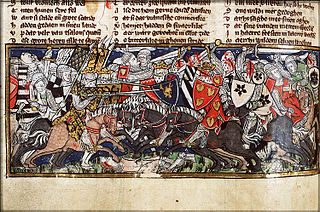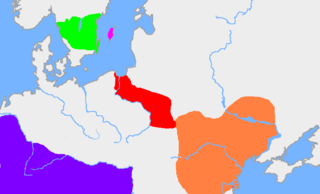
Jordanes, also written as Jordanis or Jornandes, was a 6th-century Eastern Roman bureaucrat widely believed to be of Gothic descent who became a historian later in life. Late in life he wrote two works, one on Roman history (Romana) and the other on the Goths (Getica). The latter, along with Isidore of Seville's Historia Gothorum, is one of only two extant ancient works dealing with the early history of the Goths.

Sceafa was an ancient Lombardic king in English legend. According to his story, Sceafa appeared mysteriously as a child, coming out of the sea in an empty skiff. The name also appears in the corrupt forms Seskef, Stefius, Strephius, and Stresaeus. Though the name has historically been modernized Shava, J.R.R. Tolkien used the correctly constructed modern English spelling Sheave.

The Battle of the Catalaunian Plains, also called the Battle of the Campus Mauriacus, Battle of Châlons, Battle of Troyes or the Battle of Maurica, took place on June 20, 451 AD, between a coalition – led by the Roman general Flavius Aetius and by the Visigothic king Theodoric I – against the Huns and their vassals – commanded by their king Attila. It proved one of the last major military operations of the Western Roman Empire, although Germanic foederati composed the majority of the coalition army. Whether the battle was of strategic significance is disputed; historians generally agree that the Siege of Orleans was the decisive moment in the campaign and stopped the Huns' attempt to advance any further into Roman territory or establish vassals in Roman Gaul. However, the Huns successfully looted and pillaged much of Gaul and crippled the military capacity of the Romans and Visigoths. Attila died only two years later, in 453; after the Battle of Nedao in 454, the coalition of the Huns and the incorporated Germanic vassals gradually disintegrated.

The Gepids were an East Germanic tribe who lived in the area of modern Romania, Hungary and Serbia, roughly between the Tisza, Sava and Carpathian Mountains. They were said to share the religion and language of the Goths and Vandals.

'Lancelot Du Lac, also written as Launcelot and other variants, is a character in some versions of Arthurian legend where he is typically depicted as King Arthur's close companion and one of the greatest Knights of the Round Table. In the French-inspired Arthurian chivalric romance tradition, Lancelot is an orphaned son of King Ban of the lost kingdom of Benoic, raised in a fairy realm by the Lady of the Lake. A hero of many battles, quests and tournaments, and famed as a nearly unrivalled swordsman and jouster, Lancelot becomes the lord of the castle Joyous Gard and personal champion of Arthur's wife, Queen Guinevere, despite suffering from frequent and sometimes prolonged fits of madness. But when his adulterous affair with Guinevere is discovered, it causes a civil war that, once exploited by Mordred, brings an end to Arthur's kingdom.

The Geats, sometimes called Goths, were a large North Germanic tribe who inhabited Götaland in modern southern Sweden from antiquity until the late Middle Ages. They are one of the progenitor groups of modern Swedes, along with Swedes and Gutes. The name of the Geats also lives on in the Swedish provinces of Västergötland and Östergötland, the Western and Eastern lands of the Geats, and in many other toponyms.

De origine actibusque Getarum, commonly abbreviated Getica, written in Late Latin by Jordanes in or shortly after 551 AD, claims to be a summary of a voluminous account by Cassiodorus of the origin and history of the Gothic people, which is now lost. However, the extent to which Jordanes actually used the work of Cassiodorus is unknown. It is significant as the only remaining contemporaneous resource that gives an extended account of the origin and history of the Goths, although to what extent it should be considered history or origin mythology is a matter of dispute.
Getica is a historical book, "De origine actibusque Getarum" written by Jordanes in the 6th century.

Ermanaric was a Greuthungian Gothic king who before the Hunnic invasion evidently ruled a sizable portion of Oium, the part of Scythia inhabited by the Goths at the time. He is mentioned in two Roman sources: the contemporary writings of Ammianus Marcellinus, and in Getica by the sixth-century historian Jordanes. He also appears in a fictionalized form in later Germanic heroic legends.

Scandza was described as a "great island" by Gothic-Byzantine historian Jordanes in his work Getica. The island was located in the Arctic regions of the sea that surrounded the world. The location is usually identified with Scandinavia.

King Rodulf was king of the Heruli kingdom on the Middle Danube in the period around 500, and possibly of Scandinavian origin. He died in a battle with the neighbouring Lombards which led to the splitting up of the Heruli. He is probably the same Heruli king that Theoderic the Great wrote to in two surviving letters, in one of which Theoderic "adopted" him with a gift of arms. Less certainly, he is also sometimes equated to a King Rodulf that Jordanes mentions as having come from Scandinavia to Italy, to join Theoderic.
According to a tale related by Jordanes in his Getica, Gothiscandza was the first settlement area of the Goths after their migration from Scandza during the first half of the 1st century CE. He claimed that the name was still in use in his own day.

The Gutes were a North Germanic tribe inhabiting the island of Gotland. The ethnonym is related to that of the Goths (Gutans), and both names were originally Proto-Germanic *Gutaniz. Their language is called Gutnish (gutniska). They are one of the progenitor groups of modern Swedes, along with historical Swedes and Geats.
The Charudes or Harudes were a Germanic group first mentioned by Julius Caesar as one of the tribes who had followed Ariovistus across the Rhine. While Tacitus' Germania makes no mention of them, Ptolemy's Geographia locates the Charudes (Χαροῦδες) on the east coast of the Cimbrian peninsula.

The Hilleviones were a Germanic people occupying an island called Scatinavia in the 1st century AD, according to the Roman geographer Pliny the Elder in Naturalis Historia, written circa 77 AD. Pliny's Scatinavia is generally believed to have referred to the Scandinavian peninsula, which in the 1st century AD had not yet been fully explored by the Romans and was therefore described as an island. Pliny wrote that it was an island "of a magnitude as yet unascertained". The Hilleviones lived in the only part of the island that was known, and according to Pliny, they thought of their 500 villages as a separate (alterum) world.

The Vagoth were a Germanic tribe mentioned by Jordanes as living in Scandza. They have been identified with the Geats of Vikbolandet and with the Gutes of Gotland, both in Sweden. They have been variously connected with the two places named by Jordanes, the vastissimus lacus and the Vagi fluvens. Karl Zeuss thought Vagoth to be a misspelling of Vagos and connected them to the Vagar who later appeared in the Dovrefjell of Norway. Karl Müllenhoff, too, thought the term a corruption. He proposed *Augothi or *Avigothi and placed them in Öland.
Boz was the king of the Antes, an early Slavic people that lived in parts of present-day Ukraine. His story is mentioned by Jordanes in the Getica (550–551); in the preceding years, the Ostrogoths under Ermanaric had conquered a large number of tribes in Central Europe, including the Antes. Some years after the Ostrogothic defeat by the invading Huns, a king named Vinitharius, Ermanaric's great-nephew, marched against the Antes of Boz and defeated them. Vinitharius condemned Boz, his sons, and seventy of his nobles, to crucifixion, in order to terrorize the Antes. These conflicts constitute the only pre-6th century contacts between Germanics and Slavs documented in written sources.

The name of the Goths is one of the most discussed topics in Germanic philology. It is first recorded by Greco-Roman writers in the 3rd century AD, although names that are probably related appear earlier. Derived from Proto-Germanic *Gutōz ~ *Gutaniz, it is closely related to and probably means the same as the names of both the Geats of southern Sweden and Gutes of Gotland. The implications of these similarities, and the actual meaning of the Gothic name, are disputed in scholarship. Although the Goths have disappeared as a people, their name has survived in various appellations up to the present day.
There were several origin stories of the Gothic peoples recorded by Latin and Greek authors in late antiquity, and these are relevant not only to the study of literature, but also by historians seeking evidence of real historical events involving the Goths and other peoples mentioned in these stories.

The Gothic War took place between the years 248 and 249, as well as in the year 253. Within this war, a series of battles occurred and plundering was carried out by the Goths and their allies in the eastern territory of the Roman Empire, specifically in the Balkans. With the cessation of the payment of tribute previously made by the Roman emperor Philip the Arab to the tribes beyond the Danube, the Goths and their allies, led by King Ostrogotha and his subcommanders Argedo and Gundericus, moved towards the Roman border and began a series of attacks, including against the fortified city of Marcianopolis in Thracia. After these actions, the Goths withdrew with their spoils of war.















